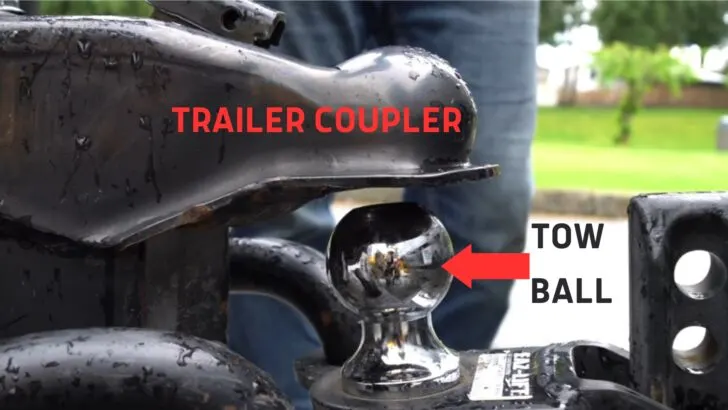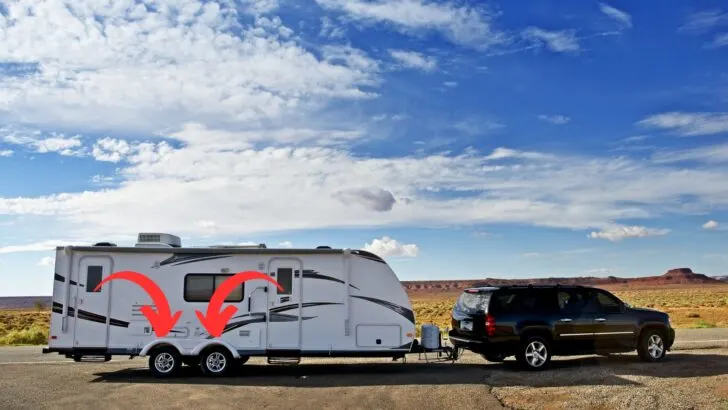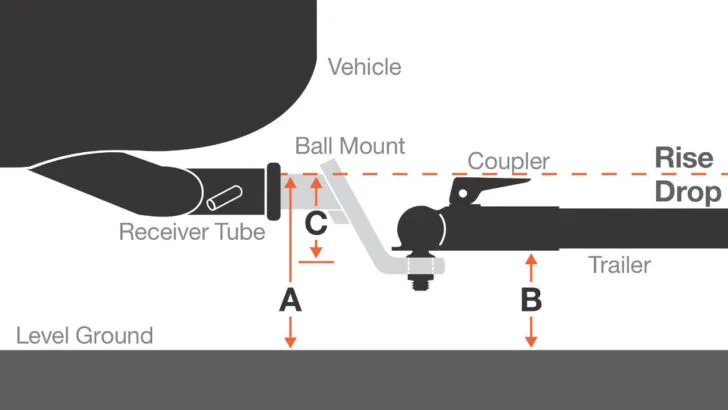Many people who tow a trailer may not be aware of the impact proper trailer hitch height has on their towing experience… and their safety. There are many things to know when towing a travel trailer (or any type of trailer, for that matter), and hitch height is only one consideration.
If you don’t maintain the proper hitch height for towing, other important factors involved in a good towing experience can be impacted. This can be to the possible detriment of your trailer, your towing vehicle, and/or your safety.
So, let’s take a deep dive into trailer hitch height, and we’ll show you exactly how significantly your towing experience can be impacted if your trailer’s hitch isn’t level.
- 1) What Does Hitch Height Mean?
- 2) Why Is Proper Hitch Height Important?
- 3) What Happens If a Trailer’s Hitch Height Is Too High or Too Low?
- 4) How Does Tow Ball Mass Impact Trailer Stability?
- 5) How Does Improper Hitch Height Impact Towing?
- 6) How to Measure for Proper Hitch Height
- 7) What Can I Do If My Hitch Is Too High or Too Low?
- 8) Final Note
- 9) Free RVing Tips, Tricks, Reviews, Giveaways & More
What Does Hitch Height Mean?
In short, the term “hitch height” refers to how high a trailer hitch is off the ground.
However, you need to know two measurements when calculating proper hitch height, because the goal is always for the trailer’s hitch and the towing vehicle’s receiver hitch to be level.
So, when parked with the tow vehicle and trailer on a level surface, you’d measure from the ground to the top of the towing vehicle’s receiver tube. You’d also measure the distance from the ground to the bottom of the trailer’s coupler. If they’re not lined up, a ball mount with a rise or drop may be needed.
We’ll review the measuring details later in the post. But first, let’s talk about why proper hitch height is so important.
Why Is Proper Hitch Height Important?
Hitch height has a considerable impact on several aspects of towing. If you read our post about tongue weight, you may recall that hitch height can have an effect on tongue weight.
If your hitch is too high, more weight will be shifted to the trailer’s axle(s). If your hitch is too low, more weight will be shifted to the towing vehicle.
Either way, your towing experience will be adversely affected, causing any one of a number of potentially serious issues. The ideal towing setup is for the trailer and the tow vehicle to be level.
What Happens If a Trailer’s Hitch Height Is Too High or Too Low?
First, a too-high or too-low hitch height impacts tow ball weight, which is also referred to as “tow ball mass.” That’s the downward force exerted onto the tow ball by the tongue weight of the towed RV. Tow vehicle, trailer, hitch receiver, and tow ball manufacturers will all specify the maximum allowable tow ball weight/mass their product(s) can handle.
Why is this important? Because tow ball weight has a significant impact on your ability to tow your trailer safely.
Maximum tow ball mass is the largest amount of weight that can be put on the ball of a towing vehicle.
At the forward end of the trailer is the part that sticks out beyond the cargo/living area. That’s the tongue, with a coupler that fits over the tow ball and connects the trailer to the towing vehicle.
As you might expect, the downward weight of the tongue is called “tongue weight,” and that force pressing down on the ball is what manufacturers limit on any particular vehicle.

The trailer coupler fits over the towing vehicle’s hitch ball, connecting the trailer to the towing vehicle.
Tow ball mass also impacts trailer stability, so you should never exceed your tow ball’s weight capacity.
You may be able to find your tow ball’s weight/mass capacity in the owner’s manual that came from the manufacturer. Or, to measure the tongue weight of your trailer to be sure it doesn’t exceed your tow vehicle’s limit, you can use a scale like this:
- Precision measurement Safer towing Generally, this nose weight gauge is the same height as your caravan, so you do not need to block it up to use it...
- Rounded ends to fit all couplings Clear accurate scale Calibrated scale using internal spring mechanism Soft tip to prevent damage to hitch Helps...
Let’s take a look at the effect of hitch height on tow ball mass, and how that impacts trailer stability, tires, and more.
How Does Tow Ball Mass Impact Trailer Stability?
Tow ball mass directly impacts the trailer’s stability and the entire towing system, so it’s important to have proper tow ball weight. Travel trailer manufacturers generally recommend a tongue weight of approximately 10% of the total (fully loaded) weight of the trailer.
So, what does tow ball mass have to do with proper hitch height?
Well, let’s take a look at what happens to a trailer’s tow ball mass when you raise a trailer’s hitch slightly above level, and what happens if you lower it slightly below level.
To offer a complete picture, we’ll look at effects on both single-axle and dual-axle trailers, because the effects are different.
Single-Axle Trailer
A single-axle trailer has one set of wheels.

This is a single-axle travel trailer because it has one set of wheels. (One wheel on each side, joined by an axle.)
If the hitch height on a single-axle travel trailer is too high, (i.e. not level with the hitch of the tow vehicle), this reduces the tow ball mass. If the tow ball mass is too light, this can cause potentially dangerous trailer sway, something everyone who tows seeks to avoid at all costs (see our post on trailer sway control for more information).
Alternatively, if the hitch height is too low (lower than the hitch of the tow vehicle), the tow ball mass will be increased. If the ball mass/ball weight is too heavy, it will increase the stress on the tow vehicle by adding a heavy load to the rear axle while also making the front axle of the vehicle lighter.
This, in turn, makes the tow vehicle’s steering lighter and changes the braking dynamics, all of which can create an unstable and dangerous situation.
Dual-Axle (Tandem-Axle) Trailer
A dual-axle or tandem-axle trailer has two sets of wheels, with the second axle positioned directly behind the first. Each axle has a wheel on each end.

A dual-axle trailer, (also called a tandem-axle trailer) has two sets of wheels to more evenly carry and distribute the weight of the rig and its contents.
The concept behind a dual-axle trailer is that four tires holding up the trailer can more evenly support and distribute the weight of the camper and its cargo.
There are two different types of dual-axle trailers.
With a load sharing dual-axle system, the weight is always evenly distributed between the front and rear axles.
So, for example, if the front wheel rises over a bump, the rear axle is forced down, leaving the pivot point in the middle and ensuring that the load is always shared between the front and back wheels.
In a load share system, you’d handle the tow ball weight situation the same as you would with a single-axle system.
A non-load share system is slightly different.
With a non-load share dual-axle trailer, the front and rear axles are not connected in any way. They’re completely separate from one another, so they function independently.
So, when one wheel rises over a bump, for example, the other wheel is completely unaffected (or, worse, completely lifted off the ground), which means the pivot point can change from being centered to being completely over one wheel or the other.
If these details seem a bit confusing, keep in mind the main goal for preventing any of these issues: making sure the hitch height is correct.
How Does Improper Hitch Height Impact Towing?
Improper hitch height can impact towing in a number of ways.
Trailer Stability is Compromised
As we noted above, improper hitch height can seriously compromise your trailer stability because it changes tow ball mass.
Remember – tow ball mass is measured when the trailer is level. If you connect to your tow vehicle and the trailer is no longer level, your tow ball mass has changed.
You Could Exceed the Tow Ball Mass Limit
If you’re close to your tow ball mass limit and you tow low (rather than level), you could exceed your tow ball mass, which you should never do.
Excessive tow ball weight can seriously compromise towing. The results can include difficulty controlling steering and braking (because the weight on the rear of the towing vehicle lightens the load on the front wheels), as well as potentially significant and dangerous sway.
Remember that your hitch ball, hitch receiver, and towing vehicle must have a weight capacity greater than the tongue weight of your trailer. For detailed information on hitch balls, trailer hitch ball mounts, and more, see our post on ball hitch sizes.
Trailer and Tow Vehicle Angles Will Be Impacted
Towing higher than level will cause the rear of the trailer to lower. This lower departure angle can cause the rear of the trailer to bottom out when driving up driveway entrance or through areas of varied or hilly terrain.
Towing lower than level will drop the front of your trailer, potentially causing the hitch and/or trailer tongue to strike the ground while driving on uneven terrain. The rear of your tow vehicle may drop as well, which affects not only driving stability but also braking. It also lifts the front end of your tow vehicle (and the angle of your headlights).
Dual-Axle Trailer Instability
If you have a dual-axle trailer, towing off-level can cause instability by affecting tire traction. It can also cause reduced braking and axle & tire overload, which in turn can cause tire blowouts.
How to Measure for Proper Hitch Height
To measure your travel trailer for proper hitch height, you’ll need your trailer and tow vehicle to be parked on level ground, and not connected to each other.
First, measure the distance from the ground to the top of the hitch receiver’s opening (A in the graphic below).
Using your trailer’s tongue jack, ensure the frame of your trailer is level to the ground (if the trailer isn’t equipped with a level, a carpenter’s level will do). Then measure the distance from the ground to the bottom of the trailer’s coupler (B in the graphic below, though be sure you’re measuring to the bottom of the coupler if it’s different from the frame of the trailer tongue).
Subtract the height of one from the other to determine which is greater and by how much:
- If the receiver is higher than the coupler, you’ll need a drop hitch equal to the difference in height (C in the graphic below).
- If the coupler is higher than the receiver, you’ll need a ball mount with a rise (again, equal to the difference in height).
Ball mounts can be fixed or adjustable and many can be used for either a drop or rise, as needed.

To determine proper trailer hitch height, you’ll need to compare the height of your tow vehicle’s receiver and the trailer coupler. (graphic courtesy of Curt Manufacturing)
What Can I Do If My Hitch Is Too High or Too Low?
If your hitch is too high or too low, there are a couple of options for addressing the drop or rise. The easiest, most reasonable thing to do is to adjust the hitch height on the tow vehicle.
Invert the Tow Hitch
If you need a ball mount with a small rise, and your tow hitch is rated to be inverted, you can invert it in the receiver to raise it a bit higher. That will simply require installing the ball upside down in the stinger and then flipping the stinger over.
Use a Drop Hitch
More commonly, you may want to bring your hitch height down. To do this, you can use either a fixed drop hitch or an adjustable model that allows you to set the amount of the drop, or rise.
- DEPENDABLE STRENGTH. Rated to tow 7,500 pounds gross trailer weight and 750 pounds tongue weight, this ball hitch offers dependability for your towing...
- VERSATILE USE. This ball mount has a 2-inch x 2-inch shank and a 6-inch drop, making it great for larger, lifted trucks and Jeeps. It also features a...
- HIGHLY VERSATILE. Adapt your trailer hitch to any towing situation with the highly versatile and easily adjustable design of this adjustable ball...
- SMOOTH TOWING. For a smoother, quieter ride while towing your trailer, this adjustable drop hitch comes with a built-in anti-rattle feature, deterring...
Weight Distribution Hitch
Sometimes, depending on the amount of rise or drop, you can use a weight distribution hitch to help distribute the trailer tongue weight across all the wheels of your towing vehicle, allowing for a more stable towing experience.
Final Note
We hope this post has illustrated why proper trailer hitch height is so important. Towing level is extremely important because hitch height impacts your towing experience in a number of significant ways.
For an excellent visual tutorial on the factors we’ve discussed in this post, we recommend this YouTube video by Robert Pepper:
Free RVing Tips, Tricks, Reviews, Giveaways & More
Subscribe to our daily newsletter! We’ve been full-time RVers for 20 years (!) and share everything we’ve learned about RVing in our daily blog posts. Join our online community to receive a wealth of great RVing knowledge delivered right to your inbox.
Whether this is your first time on the road or you’re a seasoned full-timer, you’ll love the wide range of RVing topics we cover. Don’t miss a single article or any of our famous RV gear Giveaways — Subscribe today!





Chris
Friday 19th of May 2023
No more youtube videos! We need different, clean content, video format.
Ella
Friday 19th of May 2023
Great info as always, and great video in particular. Thank you!